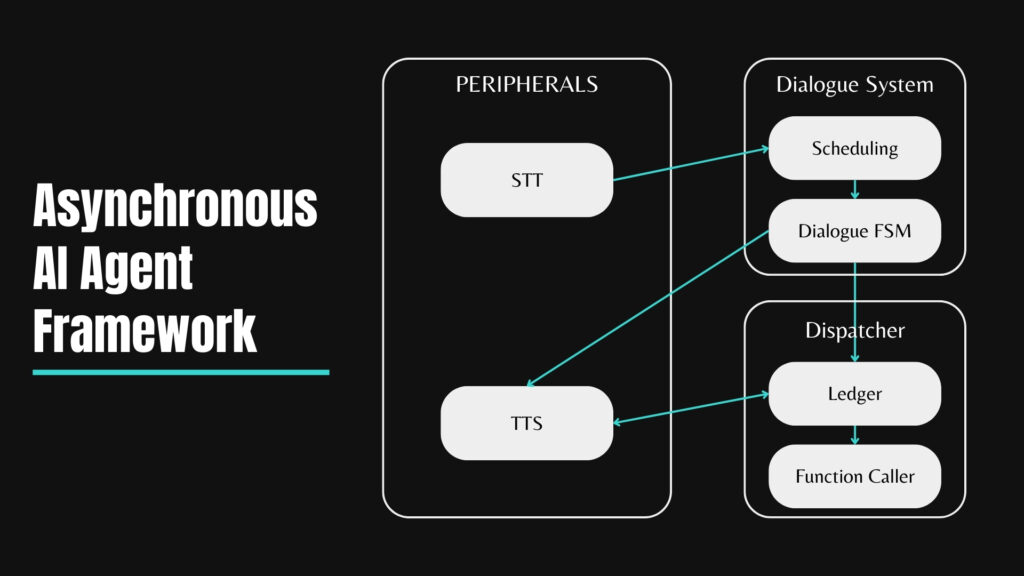Modern AI systems and large language models (LLMs) mostly operate synchronously, handling one task at a time. This restricts their ability to multitask and respond to dynamic events due to limited computation handling capacity in real-time.
So, what’s the solution? Can we find its answer in an asynchronous AI framework? Let’s check.
The asynchronous AI agent framework can handle real-time interaction and multitasking. This brings efficiency in complex scenarios. We’ll soon see the use case and real-life examples.
Briefly speaking, the AI framework integrates event-driven finite state machines (FSM), speech-to-text (STT), text-to-speech (TTS), and tools for concurrent task management, fostering advanced real-time capabilities.
Introducing asynchronous AI framework
Here are the key components of the asynchronous AI framework
1. Event-driven FSM: The finite state machine (FSM) manages states and transitions for dynamic, priority-based task execution. FSM also prioritizes high-urgency events like interruptions while ensuring low-priority tasks continue.
2. Fork and spawn mechanism: Fork shares contexts for related tasks to ensure resources are engaged efficiently and optimally; spawn creates unique workflows for independent operations.
3. Real-time interaction features: It makes use of STT for voice-based input and TTS for audio feedback. The feature integrates tools like OpenAI’s ChatML to manage real-time updates and notifications.
4. Context management: The ledger tracks events, tasks, and interactions. It supports seamless transitions and decision-making.
Use cases of asynchronous AI framework in industries
1. Healthcare: Real-time triage assistants in hospitals.
Handles patient symptoms, schedules, and emergency alerts simultaneously.
2. Finance: Intelligent financial advisors.
Executes portfolio management, real-time market analysis, and instant client updates in parallel.
3. E-commerce: Personalized shopping assistants.
Simultaneously processes order tracking, personalized product recommendations, and escalation to live agents.
4. Logistics: Fleet management for supply chain optimization.
Handles route optimization, delivery tracking, and vehicle maintenance alerts concurrently.
Drone fleet management: asynchronous AI in action
Scenario: Postearthquake disaster response. A fleet of drones performs mapping, searching for survivors, and delivering supplies.
Asynchronous vs RealTime Tasks
Real-time:
1. Drones detect survivors and reroute immediately.
2. Operators issue voice commands like “Prioritize Zone B,” triggering immediate actions.
Asynchronous:
1. Mapping, thermal imaging, and supply delivery happen simultaneously.
2. New tasks adjust specific workflows without halting unrelated operations.
How Each Component Works
1. Event-driven FSM:
Prioritizes survivor detection and task rerouting dynamically.
2. Fork/Spawn mechanisms:
Forks for shared mapping data; spawns for unique delivery routes.
3. Real-time interaction:
Alert operators about survivor locations and ongoing tasks.
4. Context ledger:
Records events like weather updates and task changes for accountability.
Salesforce Implemented Asynchronous AI
Salesforce AI Research has incorporated asynchronous features into intelligent assistants using event-driven FSMs. Their architecture handles real-time tool use, multitasking, and voice interaction. Finetuned models like GPT4o and Llama 3.1 optimize the ledger system and task prioritization. This integration improves customer engagement and task management across industries.
An Illustrative Asynchronous AI Agent Framework

Based on Cornell University research, this diagram shows the Asynchronous AI Agent Framework. It solves the problems of synchronous systems by handling concurrent tasks and real-time events.
It has three modules: Peripherals, Dialogue System, and Dispatcher. Each module contributes to asynchronous processing and communication. This is how these parts work:
1. Peripherals
Speech-to-text:
Converts voice to text for real-time user interaction. It immediately sends processed input to the Dialogue System for task scheduling.
Text-to-speech:
Ensures natural communication by speaking text responses. The system can reprioritise responses when context changes or interruptions occur.
2. Dialogue System
Scheduling:
Task priority is set by this core controller. It prioritizes emergency user interruptions over background operations.
FSM dialogue:
Helps conversational states like listening, generating, and responding transition smoothly. It handles tasks without bottlenecks, ensuring responsiveness during multiple interactions.
3. Dispatcher
A ledger:
Logs events, tasks, and outputs. Keeps historical and real-time conversation records to ensure continuity and context management.
Function Caller:
Queries databases, calls APIs, and activates tools. This can fetch real-time weather data or start a payment. These asynchronous operations don’t interrupt system functions.
Key Asynchronous Features
Non-blocking operations:
Each module works independently, allowing parallelisation. The system can process user queries and update ledger logs independently.
Dynamic task prioritisation:
Emergencies like user interruptions are handled immediately without delaying other tasks.
Management of context
The ledger keeps the AI in context, enabling smooth transitions and accurate responses.
Applications of the Framework
This framework can function for uses cases such as customer service agents, real-time virtual assistants, and enterprise automation tools benefit from its multitasking AI capabilities. The asynchronous architecture ensures scalability, responsiveness, and task reliability in dynamic environments.
Road ahead for asynchronous AI technologies
The future of asynchronous AI lies in:
Multi-modal models: Integration of text, speech, and visual data for seamless interaction.
Scalable multi-agent systems: expansion to handle larger networks of tasks and agents.
Latency reduction: Enhancing real-time responsiveness with optimized hardware and architecture.
To conclude, an asynchronous AI framework is path-breaking for complex tasks, offering smarter, faster, and interactive solutions.